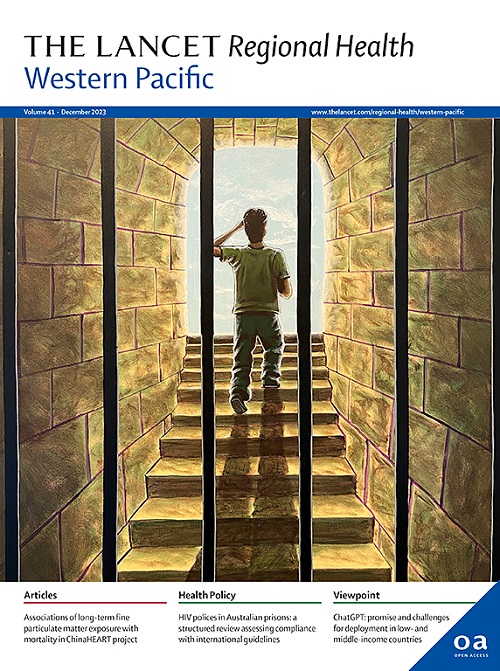新冠肺炎大流行对上海市社区老年人认知能力下降的影响:2010 - 2024年的纵向研究
IF 8.1
1区 医学
Q1 HEALTH CARE SCIENCES & SERVICES
引用次数: 0
摘要
2022年,高传染性欧米克隆变异的迅速传播导致上海感染人数急剧增加,随后社会关闭。它为研究COVID-19大流行对社区老年人认知能力下降的影响提供了机会。方法2010 - 2012年上海市中心城区3792名年龄≥50岁的社区居民参与上海老龄化研究。基线时收集人口统计学、病史、ApoE基因分型、血浆磷酸化tau217 (p-tau217)、磷酸化tau181 (p-tau181)和神经丝轻链(NfL)。2014年至2024年在基线和随访期间进行认知功能评估和MRI扫描。研究阶段定义为第一阶段(2010年1月- 12月)。2012年,基线,大流行前),第二波(2014年1月- 3月)。2022年,大流行前)和第三波(2022年6月至12月)。2024年,流行后)。采用事件研究、差异中差异(DID)和线性混合效应模型来评估大流行对认知轨迹和大脑结构变化的影响。研究结果:我们观察到,在第3波期间,迷你精神状态检查(MMSE)的年龄相关下降幅度更大。调整了年龄、性别和教育的事件研究模型显示,第3波的MMSE显著下降,但第2波没有。在血浆p-tau217、p-tau181、NfL、ApoE-ε4携带者、多重合共病或长期用药的个体中,下降更为明显。具有个体特异性随访数据的DID和线性混合效应模型显示,与波1-2相比,波2-3加速了全球认知、执行和语言功能的下降,以及结构性脑萎缩。2019冠状病毒病大流行显著加速了社区老年人的认知和大脑结构变化,特别是那些已有AD病理或健康脆弱性的老年人。这些发现为COVID-19大流行相关的认知能力下降提供了证据,并强调了对直接和间接压力源如何汇聚导致认知障碍进行机制研究的必要性。资助项目:国家自然科学基金、天桥与陈丽茜研究所、中国博士后委员会基金、伦敦大学学院:威康青年成就奖、英国皇家学会。本文章由计算机程序翻译,如有差异,请以英文原文为准。
Impact of COVID-19 pandemic on cognitive decline in community-dwelling older adults in Shanghai: a longitudinal study from 2010 to 2024
Background
In 2022, the rapid spread of the highly transmissible Omicron variant precipitated a dramatic surge in infections and a subsequent societal shutdown in Shanghai. It offers the opportunity to examine the impact of COVID-19 pandemic on cognitive decline among community-dwelling older adults.
Methods
The Shanghai Aging Study enrolled 3792 community residents aged ≥ 50 from 2010 to 2012 in central Shanghai. Demographics, medical history, ApoE genotyping, and plasma phosphorylated tau 217 (p-tau217), phosphorylated tau 181 (p-tau181), and neurofilament light chain (NfL) were collected at baseline. Cognitive function assessment and MRI scans were conducted at baseline and follow-up visits from 2014 to 2024. Study periods were defined as Wave 1 (Jan.2010–Dec.2012, baseline, pre-pandemic), Wave 2 (Jan.2014–Mar.2022, pre-pandemic), and Wave 3 (Jun.2022–Dec.2024, post-pandemic). Event study, difference-in-differences (DID), and linear mixed-effects models were employed to evaluate the pandemic’s impact on cognitive trajectories and brain structural changes.
Findings
We observed steeper age-related declines of the Mini-Mental State Examination (MMSE) during Wave 3. The event study model adjusting for age, sex, and education, showed significant MMSE decline in Wave 3, but not in Wave 2. Declines were more pronounced in individuals with high baseline plasma p-tau217, p-tau181, and NfL, ApoE-ε4 carriers, those with multi-comorbidities, or long-term medication use. The DID and linear mixed-effects models with individual-specific follow-up data revealed accelerated declines in global cognition, executive and language function, and structural brain atrophy from Wave 2–3, compared with Wave 1–2.
Interpretation
The COVID-19 pandemic significantly accelerated cognitive and brain structural changes in community-dwelling older adults, particularly among those with pre-existing AD pathology or health vulnerabilities. These findings provide evidence of COVID-19 pandemic-related cognitive decline and highlight the need for mechanistic research into how direct and indirect stressors converge to drive cognitive impairment.
Funding
National Natural Science Foundation of China, Tianqiao and Chrissy Chen Institute, China National Postdoctoral Committee Fund, UCL: Wellcome Early-Career Award and Royal Society.
求助全文
通过发布文献求助,成功后即可免费获取论文全文。
去求助
来源期刊

The Lancet Regional Health: Western Pacific
Medicine-Pediatrics, Perinatology and Child Health
CiteScore
8.80
自引率
2.80%
发文量
305
审稿时长
11 weeks
期刊介绍:
The Lancet Regional Health – Western Pacific, a gold open access journal, is an integral part of The Lancet's global initiative advocating for healthcare quality and access worldwide. It aims to advance clinical practice and health policy in the Western Pacific region, contributing to enhanced health outcomes. The journal publishes high-quality original research shedding light on clinical practice and health policy in the region. It also includes reviews, commentaries, and opinion pieces covering diverse regional health topics, such as infectious diseases, non-communicable diseases, child and adolescent health, maternal and reproductive health, aging health, mental health, the health workforce and systems, and health policy.
 求助内容:
求助内容: 应助结果提醒方式:
应助结果提醒方式:


